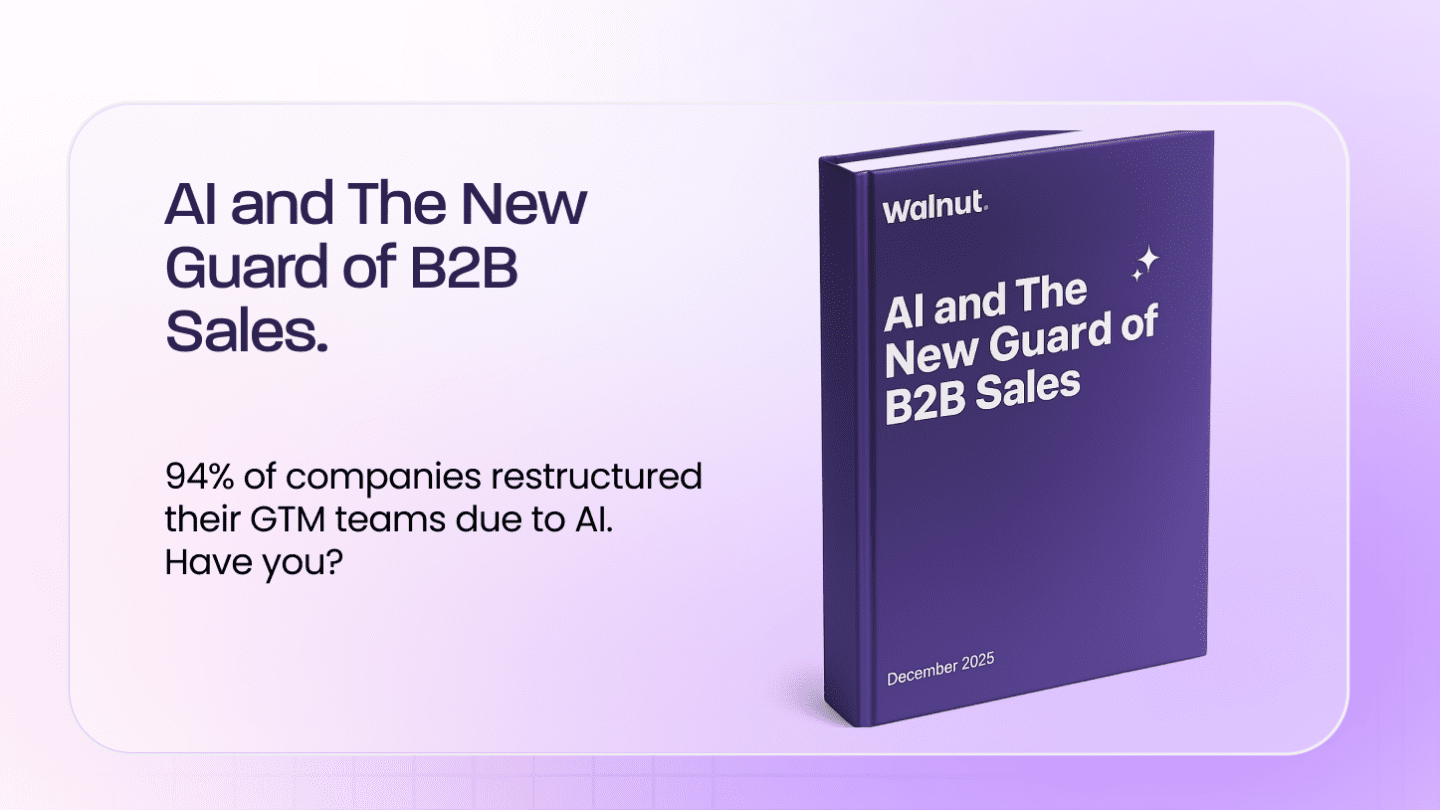It’s not about the money, money, money… Wait a minute, that’s not right.
Despite what Jessie J told us, it actually IS all about the money.
At the end of the day, it’s up to the sales team to consistently drive revenue growth. Sure, the goal is easy enough to understand, but to the sales managers trying to hit impossibly high numbers, we know it doesn’t feel that easy. That’s why sales teams are constantly looking for new ways to bring in revenue.
In this article, we’ll cover 10 tips you can implement in your sales strategy to drive serious revenue growth. Plus, we’ll break down the most important SaaS metrics you should be tracking to make sure you’re on your way to winning even more deals.
What is revenue growth?
Putting it simply, revenue growth is the increase in revenue that your business experiences over a certain period of time relative to the previous period. For example, you can compare the previous month to the current month to determine revenue growth.
What is an ideal revenue growth rate for SaaS?
No all-knowing being, person, or company can say what the “best” revenue growth rate is for SaaS companies. However, there are some general suggestions for SaaS companies at various phases of development.
Tomasz Tunguz, a venture capitalist at Redpoint, believes that a post-Seed or pre-Series A SaaS firm should aim for an MRR (monthly recurring revenue) growth rate of 15-20%.
According to SaaStr creator Jason Lemkin, it typically takes SaaS firms 7 to 10 years to increase their yearly recurring income from $1 million to over $100 million. An increase of 20% month over month is unusual but feasible.
Typically though, most SaaS businesses grow between 10% and 15% month over month.
Revenue vs. sales and earnings
Before we dive deeper, let’s make sure we’re on the same page here. Even though they sometimes get mixed up, sales and earnings aren’t the same as revenue. Here’s how they differ.
- Revenue: The total amount of money earned from all sources, such as sales, investing, licensing, fees, and more, is referred to as revenue. Costs are not taken into account.
- Sales: The proceeds from the sale of goods or services are referred to as “sales.” Additionally, they don’t account for costs.
- Earnings: Earnings subtract costs from income.
Another key distinction between sales, profits, and revenue is that while revenue growth should be viewed as a strategy rather than an objective, sales and earnings are goal-oriented.
Calculating revenue growth rates
Like it or nut (sorry couldn’t resist), we can’t talk about revenue growth without bringing up math.
Great, math. We hear you.
While learning more formulas might not be #1 on your to-do list, trust us when we say we have an integral reason for bringing them up.
Your sales team isn’t out there hustling just for the sake of it; growth needs to be effectively planned. By tracking the core SaaS metrics, you will have a better sense of the financial health of your company, sales trends, and understand what changes need to be made to keep on growing.
The revenue growth formula
Let’s kick things off with the revenue growth formula. To calculate growth, subtract the revenue of your previous cycle from your current period’s revenue. Then divide that number by your previous cycle revenue.
Revenue growth formula: (Revenue from the current period – Revenue from the previous period) ÷ Revenue from the previous period
So, if you had $1,000 in sales last month and $2,000 this month, then you had 100% growth.
This can be calculated yearly, quarterly, monthly, and so on.
Cost of Customer Acquisition (CAC)
To keep their doors open, companies need to attract new customers. So, how much will it cost to bring in these customers? Here’s how you find out.
The cost of customer acquisition (CAC) refers to the amount of money spent to acquire a new prospect.
To calculate your customer acquisition costs, you’ll first need to add up all the costs of acquiring new customers that you incurred over a certain period of time. This can include your marketing staff, campaigns, ads, sales reps, sales support materials, product demos, and more.
You’ll then divide the results by the number of customers acquired over that time.
For example, if you’re spending $30,000 on marketing per year and, at the same time, manage to acquire 120 new customers, your calculation should look like this: 30,000 ÷ 120 = 250. Thus, you’re spending an average of $250 per new customer, which is slightly below the average spent by B2B SaaS companies.
CAC formula: Total costs of acquiring new customers ÷ Number of customers acquired.
Average Revenue Per User (ARPU)
If you want to understand how much the average user will spend on your product, you’ll need to calculate the average revenue per user (ARPU).
It is a super helpful metric for SaaS providers who depend on subscriptions or users. You’ll also need this to determine monthly and annual recurring revenue, but we’ll get to that in a minute.
ARPU is calculated as:
ARPU (Average Revenue Per User) formula: Total (monthly or annual) revenue ÷ The number of subscribers in that time period.
Monthly Recurring Revenue (MRR)
To grow your revenue, you’ll need to understand how much money you’re currently bringing in each month.
The total revenue generated by a SaaS business from all active subscriptions every month is what we call monthly recurring revenue (MRR). It encompasses recurring charges from add-ons, one-time purchases, coupons, or discounts.
To calculate your MRR, multiply the average revenue per user (ARPU) by the number of monthly subscribers.
For example, if you have 10 customers on your $1,000 per month plan, your MRR will be: 10 x $1,000 = $10,000.
MRR formula: (ARPU) x (Number of monthly subscribers)
Annual Recurring Revenue (ARR)
Dun, dun, duuun! Presenting the metric of metrics.
Similar to MRR, ARR is revenue generated from subscriptions that are active for a year at a time. This metric is a must as it measures how well a company is growing its customer base.
To calculate your ARR for a specific customer, divide the total contract value by the number of years of the agreement.
For example, if you sold a 2-year subscription for $12,000, the ARR for this deal would be $6,000 because $12,000 ÷ 2 year agreement = $6,000.
ARR formula: Total amount of the deal ÷ Number of years
Customer Lifetime Value (CLV)
Now that you’ve attracted a customer, how much will they be worth to you throughout the entire relationship? Well, there’s no way to predict the future. Or, is there?
Customer lifetime value (CLV) is a metric used to determine the total amount of income a company may expect from their customer’s account throughout the relationship.
To determine CLV, you’ll first need to calculate the total revenue you’ll earn from a specific customer (or your average customer). You can do this by multiplying the annual recurring revenue (ARR) by the number of years you expect them to use your SaaS product.
You’ll then subtract the customer acquisition costs (CACs) to find your CLV.
Let’s say your average client pays $100 for a yearly subscription to your SaaS product and the average user pays for your product for 5 years. Meanwhile, your CAC costs are around $250.
First, you’ll multiply $100 by 5 and then subtract $250. This means your average CLV is $250.
CLV formula: (ARR x Average length of contract in years) – CAC
Churn Rate
No business wants to say farewell to its customers. But unfortunately, sometimes it happens. This metric will help you set your eye on the prize, which is to keep this rate as low as possible.
The churn rate measures the percentage of people who cancel subscriptions over a specified period of time.
To calculate your customer churn rate, take the number of customers you lose in a month and divide it by your total customers at the start of the month. Then multiply it by 100.
For instance, if you have 150 customers at the beginning of January and only 140 of those are still paying at the end of the month, you’ll subtract 140 from 150, which will give you the number of customers who churned, i.e. 10.
Then you’ll divide the customers you lost by your initial number of customers (10 ÷ 150 =.05) and then multiply it by 100, which should give you a total of 6.6.
This means your customer churn rate for the month of January was 6.6%, which is slightly higher than the average B2B SaaS churn rate of 4.79%
Churn rate formula: (Number of customers you lost in the month ÷ Number of customers at the start of the month) x 100
Sign-up Rate
The percentage of website visitors that sign up as a result of your marketing effort is measured by the sign-up rate. This metric is used to determine just how many viewers of your call to action really take action by signing up.
It is calculated by taking the total number of new paying subscribers and dividing it by the total number of signups in a given period.
Sign-up rate formula = (Sign ups / total people who have seen the CTA) * 100%
Expansion Revenue
Last one, we promise.
Expansion revenue refers to any new paid services that a customer adds to an already paid account. It is one of the ways many SaaS and B2B companies generate more revenue.
Expansion MRR rate formula: [(Expansion MRR at the end of the month) — (Expansion MRR at the beginning of the month) divided by the Expansion MRR at the beginning of the month] x 100
10 strategies to increase revenue growth for your SaaS
Now, this is what you’ve all been waiting for.
When it comes to improving SaaS revenue growth rates, there are a few strategies that can get you on your way to reaching those high quotas.
1. Invest in lead qualification
Why waste resources on leads that won’t ever turn into sales? This is why it is essential to make sure that your presales team qualifies your leads before proceeding with them.
To optimize your lead qualification process, you can create a profile of the ideal customer based on metrics such as the cost of customer acquisition (CAC) to determine what types of leads work best for your business.
2. Focus on reducing churn
The last thing any business wants is for its customers to leave.
One way to reduce churn is by optimizing your onboarding, customer success, and customer support.
We also want to give investing in lead qualification another shout here as it can help you attract customers who will use your SaaS product for longer periods of time.
3. Understand pain points
Why would a customer buy your product? To ease their pain!
Some of the most effective SaaS sales strategies are centered around solution selling, which focuses on alleviating customer pain points. Sales reps need to understand what makes your SaaS product a smart solution to their pain.
By addressing customer-specific pain points, you can connect with prospects on a deeper level, making them more likely to sign on the dotted line.
4. Provide your customers with additional value
Increasing your average revenue per user (ARPU) is another great way to grow revenue. You just need to find the right additional value for your existing customers.
You can do this by encouraging more usage, creating and suggesting additional features, running price testing to optimize what you charge, and offering in-app upsells and third-party cross-sells.
5. Reward your customers
Everyone loves a gift.
By rewarding your existing customers for their loyalty with unique offers, reduced rates, early access to new features, and more, you can decrease churn, boost customer loyalty, and leverage these rewards for marketing campaigns in the future. All of this goes a long way in growing revenue.
6. Optimize your B2B marketing funnel
Whether you already built your B2B marketing funnel or are just getting started, there are a lot of ways you can optimize it to drive revenue growth. That’s part of the fun…nel!
You can do this by offering webinars, and influencer campaigns, and embedding product demos on SEO-optimized landing pages.
By optimizing your funnel, you can efficiently spend your resources and get the best results.
7. Improve your onboarding processes
Customer onboarding isn’t just employee orientation.
It’s also the way new clients are welcomed to a business. With an effective onboarding process, you can positively improve metrics like churn rate, lead time, retention rate, engagement rate, demo conversion rate, and more.
And when it comes to customer onboarding, Walnut has you covered. With Walnut demos, it’s easy to show that you understand your client’s challenges and have solutions for them.
8. Optimize and measure your SaaS and B2B sales benchmarks
Sales reps all have a common goal: to hit that GONG. To get there, sales managers use SaaS sales benchmarks to set tangible goals for their teams.
By establishing sales benchmarks, you can make sure your team has what it needs to close deals and hit gongs.
9. Use SaaS metrics to evaluate your decision-making process
When it comes to increasing revenue, every metric we discussed in this article is important. Tracking every single one and performing corrective actions when insights are gleaned ensures that you are doing what you can to grow your revenue by optimizing everything across the board.
However, these are not, by any means, the only SaaS metrics you can use. Anything that relates to your goal should be tracked to optimize your approaches to increase revenue continuously.
10. Create better product demos
The first impression of a product can make or break the sale. In the right hands, a good demo can be a powerful tool for enabling sales and demonstrating the true value of your SaaS product. And a bad one, well, can send very frustrated and bored prospects running in the opposite direction.
An interactive product demo can demonstrate your solution’s ability to eliminate pain points and why a prospect should choose your product over your competitors’ solutions.
Boost your revenue growth with interactive demos
Ramping up revenue means arming your sales team with the software they need to close more deals.
With product demo software like Walnut, sales teams can create sales demos that are tailor-made to suit every segment of your audience. This will help bring more value to your prospects quicker and create a better buying experience for both parties.
On top of this, you can also use your interactive product demos to sell smarter by gaining insights that can be used to optimize your team’s performance across all customer acquisition and retention strategies.
And all of this adds up to higher revenue.
So, what’s the holdup? Push the “Get Started” button at the top of your screen to start increasing revenue growth!





